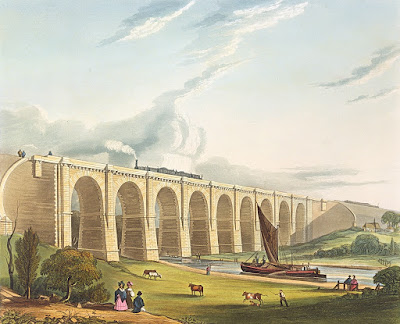This wasn't a story I was aware of until I saw something recently posted on the
Bridgehunter's Chronicles blog.
The
Pont des Trous (translation: "bridge of holes") in Tournai was a medieval structure spanning the Scheldt River. Three arches, built at the end of the thirteenth century, connected two defensive towers, part of a historic city wall system. According to
one report, this was one of only three remaining 13th century defensive bridges in the world (although ... read on!)
Here is this attractive heritage bridge pictured last year:
 |
| Image courtesy of Trougnouf via Wikimedia Commons CC BY-SA 4.0 license |
And here is how it looked on 14th August this year, following major demolition work:
 |
| Image courtesy of Jpcuvelier via Wikimedia Commons CC BY-SA 4.0 license |
If you spot that the towers look different in the two photos, that's because the photos are taken from different sides of the bridge: the curved tower faces were apparently on the outside of the city walls, to better deflect cannon-shot.
After much debate, the arches
have been demolished in the name of progress. Apparently, the 1500-tonne vessels that could pass through the central arch are not enough, so the bridge had to make way to allow 2000-tonne vessels to pass.
Demolition of such a historic structure seems quite suprising, even with the stated justification of improving the local economy. There have been
a petition against the proposal, and
a Facebook protest group.
However, the structure that has been destroyed was not actually the original 14th century bridge, shown here in an old illustration with three equal gothic arches and a roof covering.
The bridge was then destroyed by the British during the second world war. This image showing the damage to the medieval bridge dates from circa 1940:
When the
bridge was rebuilt, it was essentially entirely erased and then reconstructed to some extent in reinforced concrete with a masonry facing - the bridge that has now been destroyed was essentially a fake, although many visitors would never realise this. The central arch was raised and widened enlarged at this time.
There have been various plans put forward to replace the demolished bridge with
a modern structure.
A stone version of the same idea was preferred in a consultation with residents (although the consultation didn't include the possibility of retaining the existing structure).
This alternative proposal is from architect Olivier Bastin, a more skeletal reconstruction. It feels more like a parody of a bridge, than any meaningful tribute to what was there before.
Michel Wiseur's alternative is the best of this sorry bunch, displaying clearly the site's history rather than replacing it with something of entirely different dimensions or materials:
I gather that all these proposals have now fallen by the wayside, and the local authorities have stated they intend to rebuild the bridge (on another site?), stone-by-stone. If you watch
the video of its demolition, you may wonder quite how that will actually happen.
My first thought on hearing about this whole story was that it was really quite appalling. Heritage can either be preserved or lost, and it can only be lost once. Once lost no Disney-like confection can replace it. However, here is a bridge that can apparently be lost twice, and the bridge that has been destroyed is not what it may have seemed.
So is it really such a loss after all? It is perhaps more significant as an element of civic identity than as a piece of real heritage. As with much nostalgia, the sense of loss is for a representation of the past that was never real or authentic anyway.
 The Canal dates all the way back to 1757, but Historic England suggest that the Grade II Listed bridge dates from around 1857. The Listing states that the turning gear and pivot remain in place, although clearly the bridge is no longer operational, and the canal reaches a dead-end a short distance to the north of here.
The Canal dates all the way back to 1757, but Historic England suggest that the Grade II Listed bridge dates from around 1857. The Listing states that the turning gear and pivot remain in place, although clearly the bridge is no longer operational, and the canal reaches a dead-end a short distance to the north of here. If the 1857 date is correct, it must be one of the oldest surviving stayed bridges in England (there are certainly older examples in Scotland). It's not clear how much of the bridge is original - Historic England date the parapets to the 20th century, and there are turnbuckles in the main rods which are clearly an alteration.
If the 1857 date is correct, it must be one of the oldest surviving stayed bridges in England (there are certainly older examples in Scotland). It's not clear how much of the bridge is original - Historic England date the parapets to the 20th century, and there are turnbuckles in the main rods which are clearly an alteration.



















